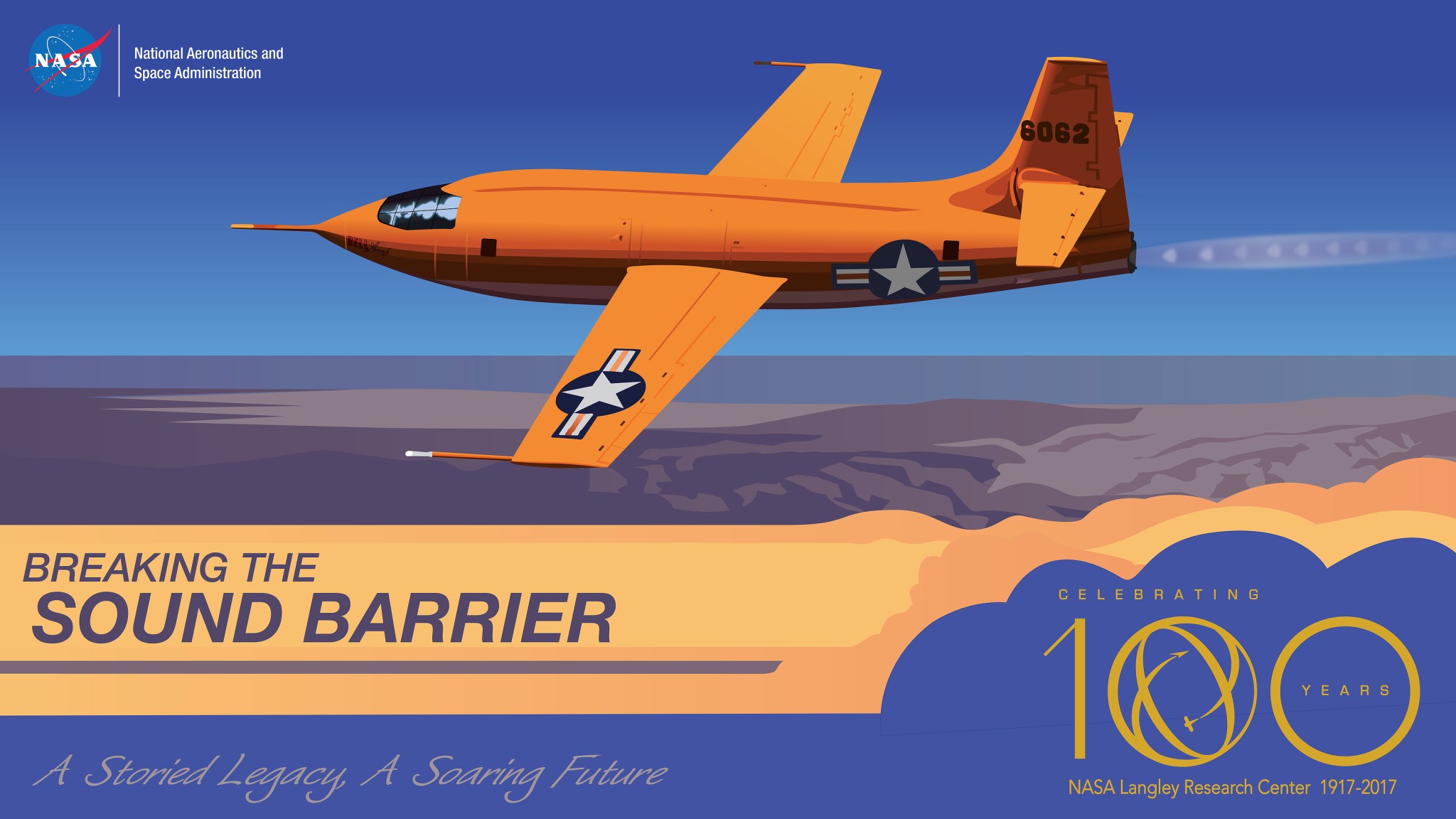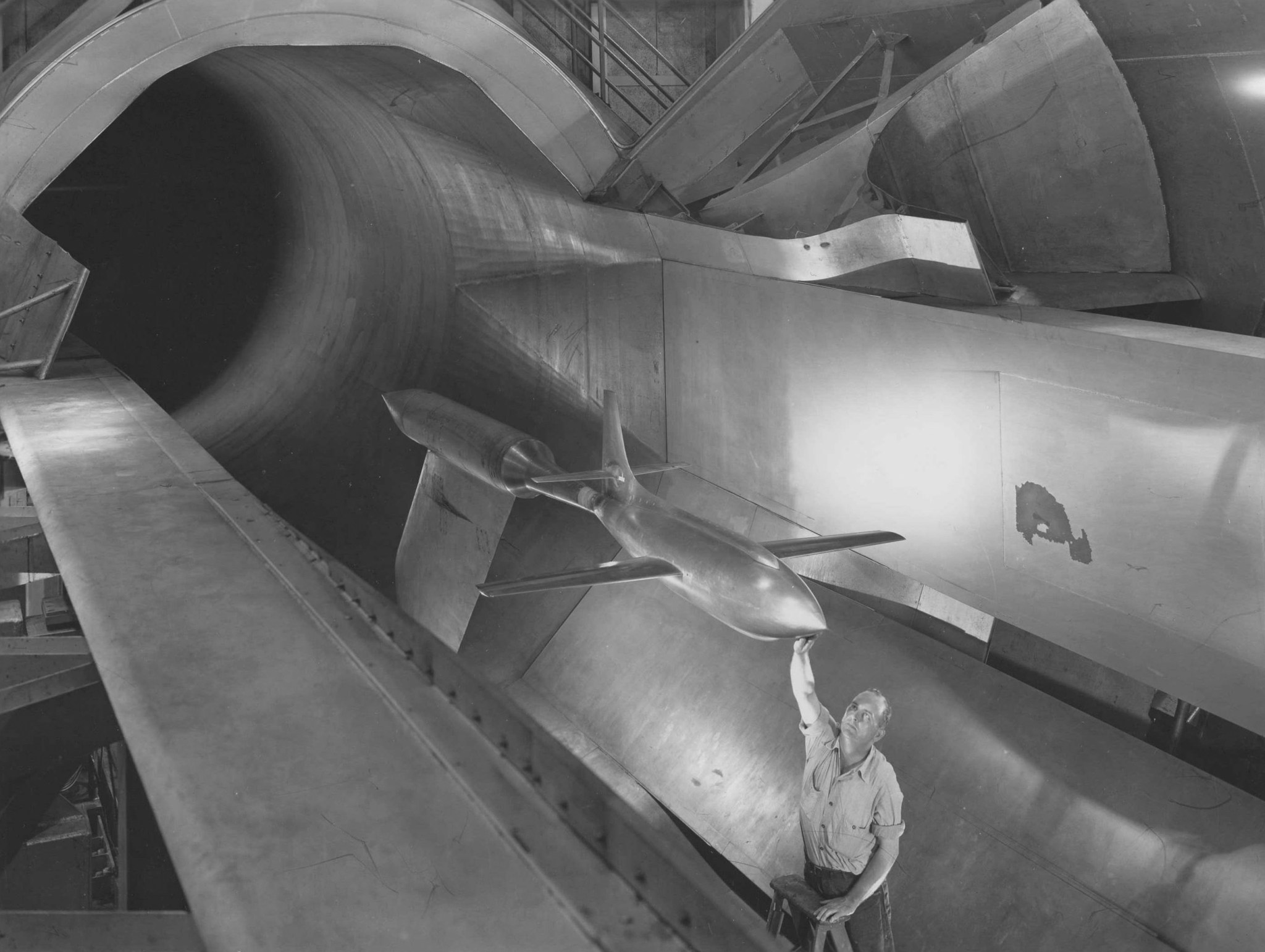Humans delight in speed. History reveals ever more engineered acceleration: a transition from competitive running on two legs to auto racing on roads, from horse-drawn locomotion to high-speed train travel, from transcontinental aerial treks to space-station shuttle launches. Aeronautics would play a central role in the tale. As amazing as the first powered flights appeared to early 20th century citizenry, the quest to go fast, faster and fastest was just beginning. The simple goal was to soar as swiftly as the laws of nature permitted.
At what was first known as the Langley Memorial Aeronautical Laboratory, high-speed research concentrated on catapulting past speeds from the low hundreds to the high. Ingenious airfoil shapes developed at Langley were employed to design high-speed propellers in the 1930s and 1940s. Work on practical jet propulsion intensified. Engineers assessed materials, structures and controls to accommodate higher speeds. Langley was essential in helping the military to muscle through the sound barrier. The dial would be turned even higher as Langley’s “hypersonics” research ignited, ultimately leading to experimental craft capable of flight at several speed-of-sound multiples.
The imperatives of a world war spurred higher-speeds interest. Both the British and Germans developed operational jets, although their use was limited and didn’t affect World War II’s outcome. Even though possible, it wasn’t very practical to routinely fly jets, given issues such as reliable engines, high fuel use, flight-disrupting aerodynamics, difficult handling, and precarious stability. The primary problem was compressibility effects, the tendency of shock waves to blossom and proliferate as airplanes moved quickly through the atmosphere.
Langley’s design and construction in 1947 of a “slotted throat” wind tunnel changed the equation by helping aerodynamicists understand the forces acting on aircraft flying at or beyond 500 miles per hour (805 kilometers per hour).
Outsmarting the Choke
As aircraft flew ever faster, compressibility emerged as a severe threat to airworthiness. Think ships buffeted by heavy swells: as swirls of accumulating air violently slapped surfaces and structural components, propellers and wings, as drag shot up and lift evaporated, aircraft could experience the aeronautical equivalent of nautical sinking. Staying consistently aloft under such conditions would prove not just a matter of expert piloting, but innovation in aircraft architectures.
But how to understand and account for these forces in airplane design, modification and operation? Langley’s solution was a revolutionary redesign of the interiors of two facilities, the 8-Foot and the 16-Foot High Speed Tunnels. Slots placed in both tunnels’ test-section throats, where models or model components were mounted, allowed for ventilation to eliminate the phenomenon known as “choking,” the generation of shock-wave interference patterns on unslotted tunnel walls. This slotted-throat approach allowed accurate data collection as air was efficiently channeled around the models and speeds crept up to and slightly past the speed of sound: roughly 760 miles per hour (1,223 kph) at sea level and 660 mph (1,062 kph) at altitudes of 35,000 feet (10,668 meters) and above. (High flight speeds are often expressed in Mach number multiples, as a tribute to Austrian physicist Ernst Mach, famed for his exploration into the physics of sound.)
The slotted-throat advance made possible another critical breakthrough, that of the area rule. Working in the 8-Foot High Speed Tunnel, Langley researcher Richard Whitcomb discovered if an airplane fuselage was sufficiently narrowed to mimic the shape of an old-fashioned soda bottle, drag would decrease and speed increase through what is known as the “transonic” realm: speeds a little below through a little above supersonic. Whitcomb’s realization would net him not only aeronautics’ premier award, the Collier Trophy — also given to the inventors of the slotted-throat tunnel — but make practical jet flight possible. Whitcomb wasn’t finished, though. Another creation, that of the supercritical wing, would delay the onset of drag and increase the fuel efficiency of aircraft flying close to the speed of sound.
In the space of just a few years, knowledge of the transonic realm would transform not only military flight, but civilian as well. Another scene-stealer would likewise debut, this one also involving Langley as a key member of the cast.
The Barrier and Beyond
The phrase made for a better news story, even if its originator didn’t intend it to be so. In remarks made to a reporter in 1935, British aerodynamicist W. F. Hilton first used the phrase “sound barrier.” He said that an airplane wing’s resistance to high speeds “shoots up like a barrier” the closer to the speed of sound one flies. Supersonic speeds presented vexing challenges, ones that worried designers and engineers alike. Could aircraft be controlled at such high speeds? Would structures survive higher stresses and temperatures? Given the many drawbacks, was supersonic flight realistic at all?
Unique transonic-design, aerodynamic, propulsion, and wind-tunnel research conducted at Langley was in part responsible for the mid-October day in 1947 when then-U.S. Air Force Captain Charles E. “Chuck” Yeager briefly broke through to supersonic flight in the rocket-powered Bell X-1, the first of a series of high-speed research aircraft known collectively as X-planes. The 1947 Collier Trophy went to Yeager, Langley’s John Stack, and Bell Aircraft Corporation president Lawrence Bell in recognition of their research accomplishments in faster-than-sound flight.
Although the Langley-originated area rule found application in the design of military jet fighters, concerns over environmental impact and technological and economic constraints kept commercial flight largely subsonic — with the notable exception of the Concorde, for those wealthy enough to afford the ticket prices. As a follow-on to 1960s and ’70s-era research into a potential supersonic transport, beginning in 1990, the Langley-based High-Speed Research (HSR) Program was a NASA-industry collaboration to develop a concept for a next-generation supersonic passenger jet carrying 300 passengers at more than 1,500 miles per hour (2,414 kph). Although phased out in 1999 because of economic constraints, the HSR effort set new standards in concepts for propulsion systems, materials and structures, cockpit controls, and assessment of environmental impacts.
The newest Langley-led supersonic-research initiative was announced in 2016: a collaboration with an industry team led by aerospace company Lockheed Martin to assess quiet supersonic technology, or QueSST. The team will provide concept formulation and planning for detailed design, building and testing of a piloted QueSST jet, part of NASA’s latest X-plane initiative known as New Aviation Horizons.
Space-Certified Fast
The next barrier for air travel looks hyper: hypersonics, a regime that begins at Mach 5, five times the speed of sound, or 3,300 miles per hour (5,311 kph) at altitude. Langley’s work with hypersonics was spurred in part in the 1940s by the post-war discovery of a German Mach 5 wind tunnel. Langley engineer John Becker led support for flight tests of a hypersonic research vehicle, and oversaw a study group that proposed an effort leading to the X-15 airplane project. Becker provided general supervision of design elements for X-15 aerodynamic and structural characteristics, initiating studies that led to improvements in stability and control.
By the time the nearly 10-year program ended at 199 flights in October 1968, an X-15 had been flown to a blistering speed of Mach 6.7 (about 4,500 mph, or 7,242 kph), a record that still stands for winged aircraft. The X-15 program demonstrated that pilots could exit Earth’s atmosphere in rocket-powered vehicles, successfully control them in an airless environment, reenter the atmosphere, and then land at a predetermined site.
Langley’s hypersonics research continued with studies on propulsion, thermal effects and structural integration for the National Aerospace Plane, or NASP; the Hyper-X effort that included the U.S. Air Force X-43 vehicle; and the Air Force X-51 “Waverider.” Langley was also a major participant in HIFiRE, the Hypersonic International Flight Research Experimentation Program aimed at exploring the fundamental technologies needed to achieve practical hypersonic flight.
For hypersonics, extreme speeds mean extreme challenges of atmospheric flight, including very high surface temperatures, next-generation engines, inexpensive-enough fuel, and rugged controls and control systems. But,if researchers could achieve routine and affordable hypersonic flight, even the farthest reaches of the globe would be a few hours away and not a dozen or more as is currently the case. Langley’s hypersonics research might lead to the biggest prize of all: direct flight into space from terrestrial airports, forever changing the meaning of the words “fast” and “travel.”
































